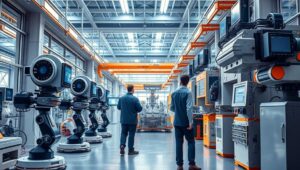The AI-Powered Manufacturing Plant of the Future (2026)
The manufacturing landscape is undergoing a dramatic transformation, driven by the rapid advancements in Artificial Intelligence (AI). By 2026, the integration of AI into manufacturing plants will be so profound that it will fundamentally redefine how products are designed, produced, and distributed. This article explores the key AI-driven technologies and applications that will shape the future of manufacturing.
AI-Powered Predictive Maintenance
One of the most significant applications of AI in manufacturing is predictive maintenance. By analyzing data from sensors embedded in machinery, AI algorithms can predict when equipment is likely to fail. This allows manufacturers to schedule maintenance proactively, minimizing downtime and reducing repair costs. Consider a scenario where an AI system detects subtle anomalies in a robotic arm’s motor. Instead of waiting for a catastrophic failure, the system alerts maintenance personnel to replace the motor during a scheduled break, preventing hours of lost production.
AI-Driven Quality Control
Quality control is another area where AI is making a substantial impact. Traditional quality control methods often rely on manual inspections, which can be time-consuming and prone to errors. AI-powered vision systems, on the other hand, can quickly and accurately identify defects in products. These systems use cameras and machine learning algorithms to analyze images of products in real-time, flagging any deviations from the expected standards. This ensures that only high-quality products reach the market, enhancing customer satisfaction and reducing waste.
AI-Optimized Supply Chain Management
Supply chain management is a complex and dynamic process, involving numerous variables such as demand fluctuations, transportation delays, and inventory levels. AI can optimize supply chain operations by analyzing vast amounts of data to predict demand, identify potential disruptions, and optimize logistics. For example, an AI system can analyze historical sales data, weather forecasts, and economic indicators to forecast demand for a particular product. This allows manufacturers to adjust production schedules and inventory levels accordingly, minimizing stockouts and reducing carrying costs.
AI-Enhanced Robotics and Automation
Robotics and automation have long been integral to manufacturing, but AI is taking these technologies to the next level. AI-powered robots can perform tasks that were previously impossible for traditional robots, such as adapting to changing conditions and collaborating with human workers. These robots use sensors and machine learning algorithms to perceive their environment, make decisions, and execute tasks with greater precision and efficiency. In a modern manufacturing plant, you might find AI-powered robots assembling complex products, handling delicate materials, or performing repetitive tasks, freeing up human workers to focus on more creative and strategic activities.
The Impact on the Workforce
While the integration of AI into manufacturing plants offers numerous benefits, it also raises concerns about the impact on the workforce. As AI-powered systems automate more tasks, some jobs may become obsolete. However, AI also creates new opportunities for workers with the right skills. To prepare for the AI-driven manufacturing plant of the future, workers will need to develop skills in areas such as data analysis, machine learning, and robotics. Additionally, there will be a growing demand for workers who can maintain, troubleshoot, and improve AI-powered systems.
Challenges and Considerations
Despite the potential benefits, there are several challenges and considerations that manufacturers must address when implementing AI. These include:
- Data Availability and Quality: AI algorithms require large amounts of high-quality data to train effectively. Manufacturers must ensure that they have access to the necessary data and that it is accurate, complete, and consistent.
- Integration Complexity: Integrating AI into existing manufacturing systems can be complex and costly. Manufacturers must carefully plan their AI deployments and ensure that the new systems are compatible with their existing infrastructure.
- Cybersecurity Risks: As manufacturing plants become more connected and data-driven, they also become more vulnerable to cyberattacks. Manufacturers must implement robust cybersecurity measures to protect their data and systems from unauthorized access.
- Ethical Considerations: The use of AI in manufacturing raises ethical concerns about issues such as bias, transparency, and accountability. Manufacturers must ensure that their AI systems are fair, transparent, and aligned with their values.
Conclusion
The AI-powered manufacturing plant of the future promises to be more efficient, productive, and resilient than ever before. By leveraging AI-driven technologies such as predictive maintenance, quality control, supply chain optimization, and robotics, manufacturers can improve their operations, reduce costs, and enhance customer satisfaction. While there are challenges and considerations to address, the potential benefits of AI are too significant to ignore. As we move closer to 2026, manufacturers that embrace AI will be well-positioned to thrive in the rapidly evolving global economy.




